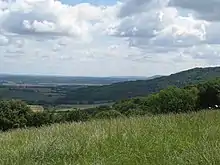Duncton to Bignor Escarpment
Duncton to Bignor Escarpment is a 229-hectare (570-acre) biological Site of Special Scientific Interest west of Pulborough in West Sussex.[1][2] It is a Special Area of Conservation[3] and Bignor Hill is a Nature Conservation Review site, Grade I.[4]
| Site of Special Scientific Interest | |
 | |
| Area of Search | West Sussex |
|---|---|
| Grid reference | SU 971 143[1] |
| Interest | Biological |
| Area | 229.0 hectares (566 acres)[1] |
| Notification | 1986[1] |
| Location map | Magic Map |
Ecosystem
This steeply sloping site on the South Downs has mature beech woodland together with other habitats including chalk grassland and scrub. Invertebrates include the largest British population of the snail Helicodonta obvoluta and several rare moth species. A spring has a rich marginal vegetation including opposite-leaved golden saxifrage.[5]
References
- "Designated Sites View: Duncton to Bignor Escarpment". Sites of Special Scientific Interest. Natural England. Retrieved 23 April 2019.
- "Map of Duncton to Bignor Escarpment". Sites of Special Scientific Interest. Natural England. Retrieved 23 April 2019.
- "Designated Sites View: Duncton to Bignor Escarpment". Special Areas of Conservation. Natural England. Retrieved 6 April 2019.
- Ratcliffe, Derek, ed. (1977). A Nature Conservation Review. 2. Cambridge, UK: Cambridge University Press. p. 47. ISBN 0521 21403 3.
- "Duncton to Bignor Escarpment citation" (PDF). Sites of Special Scientific Interest. Natural England. Retrieved 23 April 2019.
| Wikimedia Commons has media related to Duncton to Bignor Escarpment. |
This article is issued from Wikipedia. The text is licensed under Creative Commons - Attribution - Sharealike. Additional terms may apply for the media files.